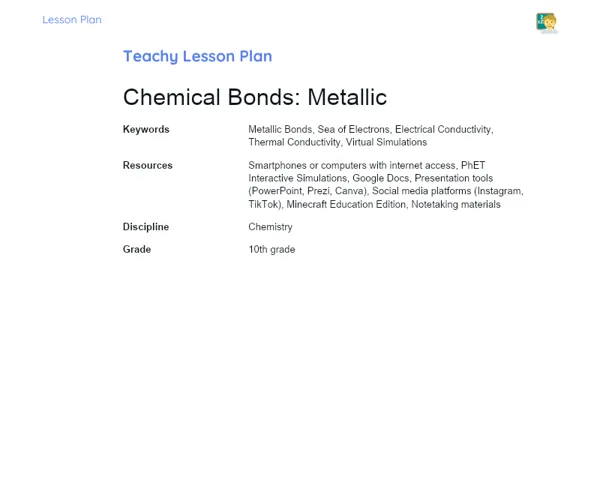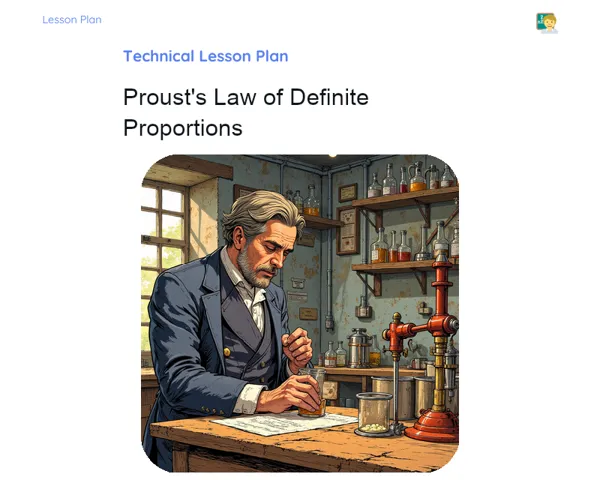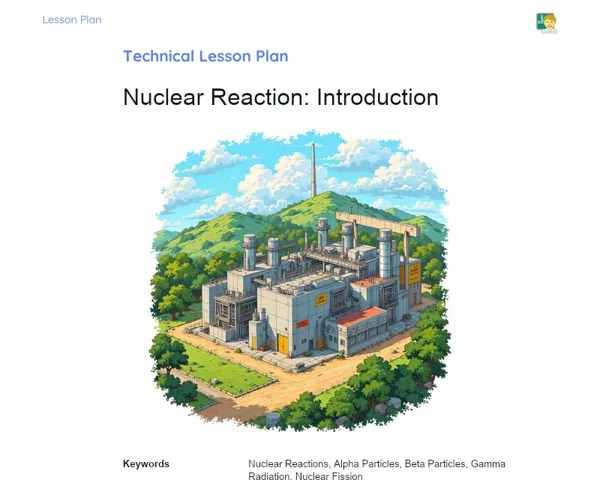Lesson Plan | Active Methodology | Ionic Equilibrium
| Keywords | Ionic Equilibrium, Weak Acids and Bases, Buffer Solutions, Practical Applications, Problem Solving, Teamwork, Critical Thinking, Chemical Reactions in Solutions, pH Control, Project Development, Culinary Competition, Group Discussion, Reflection and Recap |
| Necessary Materials | Damaged sheets of paper, Ionization constant tables, List of potential acids and bases, Data on the water's chemical composition, pH indicators, Culinary ingredients with varying pH levels, Computers for simulations, Materials for presentations (paper, pens), Equipment for preparing solutions (benches, bottles, pipettes) |
Premises: This Active Lesson Plan assumes: a 100-minute class duration, prior student study both with the Book and the beginning of Project development, and that only one activity (among the three suggested) will be chosen to be carried out during the class, as each activity is designed to take up a large part of the available time.
Objective
Duration: (5 - 10 minutes)
This part of the lesson plan is vital as it lays the groundwork for what students are expected to achieve by the end of the session. Clearly defining these goals provides students with precise guidance on what they need to revise beforehand and how to use that knowledge during the class. Additionally, this section helps harmonise the teacher's expectations with the intended educational outcomes, aiding in evaluating the effectiveness of the teaching.
Objective Utama:
1. Equip students to tackle problems related to the equilibrium of substances that dissociate or ionize, focusing particularly on weak acids and bases.
2. Develop students' skills to apply concepts of ionic equilibrium to predict how solutions behave under varying conditions.
Objective Tambahan:
- Encourage active student participation in discussing practical scenarios that demonstrate ionic equilibrium.
Introduction
Duration: (15 - 20 minutes)
The introduction aims to connect students’ prior knowledge with real-world situations. By presenting problem-based scenarios, we stimulate critical thinking and direct application of the concepts being studied. This contextualization highlights the real-life importance of ionic equilibrium, boosting student engagement and emphasising the significance of the topic across various practical domains.
Problem-Based Situation
1. Imagine you’re a chef who needs to balance a dish that has turned out too acidic. How can your knowledge of ionic equilibrium help neutralise the excessive acidity while keeping the dish's flavour intact?
2. A farmer uses a phosphoric acid solution to adjust the pH of the soil. How do variations in soil conditions, such as temperature and humidity, affect the ionic equilibrium of this solution and its efficiency in correcting the pH?
Contextualization
Ionic equilibrium is crucial not only in chemistry labs but also in various day-to-day situations, such as water purification, agricultural practices for soil pH adjustment, and even culinary arts. Understanding the actions and reactions of ions in solutions helps predict and control these processes, enhancing their practical implementation. Engaging facts, like how certain fish can detect shifts in water pH using sensors in their gills, can pique students' interest and underscore the relevance of studying ionic equilibrium.
Development
Duration: (70 - 75 minutes)
This development phase of the lesson plan immerses students in practical and thought-provoking scenarios that necessitate the direct application of previously covered concepts of ionic equilibrium. The activities are designed to encourage critical thinking, problem-solving, and teamwork, which are crucial for developing practical chemistry skills. Each activity is crafted to be engaging and educational, allowing students to consolidate their learning through relevant and contextual applications.
Activity Suggestions
It is recommended that only one of the suggested activities be carried out
Activity 1 - The Mystery of the Forgotten Solution
> Duration: (60 - 70 minutes)
- Objective: Apply concepts of ionic equilibrium to solve a practical problem, while fostering teamwork and critical thinking skills.
- Description: In this activity, students become detectives tasked with uncovering the lost formula for an essential buffer solution critical to a chemical company. The formula was carelessly left in the lab, and part of the document was damaged by an acid spill. Students will use their ionic equilibrium knowledge to reconstruct the original formula based on the clues left behind by an absent-minded chemist.
- Instructions:
-
Form groups of up to 5 students.
-
Distribute materials: the damaged sheet of paper, ionization constant table, and a list of potential acids and bases that could create the buffer solution.
-
Each group should analyse the damaged sheet and utilise the clues to piece together the original formula of the buffer solution.
-
Students must calculate the pH of the original buffer solution and compare it with that of a prepared solution to validate their deductions.
-
Each group will present their findings and reasoning process to the class.
Activity 2 - The Perfect pH Challenge
> Duration: (60 - 70 minutes)
- Objective: Develop practical application skills relating to ionic equilibrium to tackle environmental and public health challenges.
- Description: Here, students take on the role of chemical engineers responsible for designing a water treatment system for a city facing issues with pollution and improper pH levels. They need to utilise their understanding of ionic equilibrium to devise a solution that keeps the water’s pH within acceptable limits while eliminating harmful ions.
- Instructions:
-
Form groups of up to 5 students.
-
Provide data on the water composition of the city and the acceptable pH limits.
-
Students should create a solution using principles of ionic equilibrium to adjust the pH and remove undesirable ions, such as heavy metals.
-
Each group will prepare a presentation of their project, explaining the chemical processes involved and the anticipated effectiveness.
-
Conduct a computer simulation or a small-scale water treatment test to verify the students' hypotheses.
Activity 3 - Chemical MasterChef
> Duration: (60 - 70 minutes)
- Objective: Apply ionic equilibrium knowledge in a fun and practical way, enhancing the understanding of how ions impact flavours and textures.
- Description: Students engage in a culinary contest where they must use their understanding of ionic equilibrium to concoct the perfect sauce, balancing acidity and basicity. Each group is provided with ingredients that have varying pH levels and must adjust the final pH of the sauce to achieve the ideal taste.
- Instructions:
-
Divide the class into groups of up to 5 students.
-
Each group receives a box of ingredients that includes acids, bases, and pH indicators.
-
Students will use ionic equilibrium theory to adjust the pH of their ingredients and create a sauce with an optimal balance of acidity and basicity.
-
After preparing their sauces, each group will share their recipe and the chemical processes they employed to achieve the desired balance.
-
Organise a tasting session to evaluate how well the groups managed to adjust the pH.
Feedback
Duration: (15 - 20 minutes)
This stage of the lesson plan is vital for reinforcing student learning, allowing them to reflect on the knowledge they have gained and share their insights with classmates. The group discussion reinforces the understanding of ionic equilibrium concepts, allowing students to articulate their thoughts and receive immediate feedback from both peers and instructors. Moreover, this exchange of ideas fosters a collaborative learning environment, where different perspectives can be appreciated and explored.
Group Discussion
At the end of the activities, organise a group discussion with all students to share their experiences and insights. Kick off the discussion with a brief introduction, where each group summarises what they did and the solutions they arrived at. Encourage students to talk about the challenges they faced and how they applied concepts of ionic equilibrium to tackle these issues. This moment is vital for students to articulate their learning and consider diverse approaches from their peers, enhancing the overall learning experience.
Key Questions
1. What were the main challenges your group encountered when applying ionic equilibrium concepts during the activities?
2. How did the theory of ionic equilibrium assist you in understanding and solving the practical problems presented?
3. Was there any surprising or unexpected revelation during the activities that altered your initial interpretation?
Conclusion
Duration: (5 - 10 minutes)
The aim of this stage in the lesson plan is to ensure students have a solid and clear grasp of the discussed concepts. Recapping the main points aids in reinforcing learning and ensures that students can apply their newly acquired knowledge to different contexts. Additionally, by emphasising the connection between theory and practice, the conclusion highlights the everyday relevance of ionic equilibrium and its importance for future career paths.
Summary
In concluding the lesson, it’s important to summarise and recap the key concepts related to ionic equilibrium, solidifying students' understanding. At this point, the teacher should revisit topics such as weak acids and bases, buffer solutions, and their practical applications, such as pH regulation in industrial processes and everyday situations.
Theory Connection
Today’s lesson was designed to seamlessly connect theory with practice. The proposed activities enabled students to apply theoretical concepts directly to real-world contexts, such as the chef managing an overly acidic dish and designing a water treatment system. These practical applications reinforce the significance of ionic equilibrium in both everyday and industrial contexts.
Closing
Grasping ionic equilibrium is essential not just for academic success in chemistry, but also for its practical implications across various fields. The ability to predict and adjust chemical reactions in solutions is crucial for professionals in labs, industries, or areas such as health and environmental science. Furthermore, studying ionic equilibrium enhances our understanding of everyday natural phenomena, such as how fish can sense changes in water pH.



